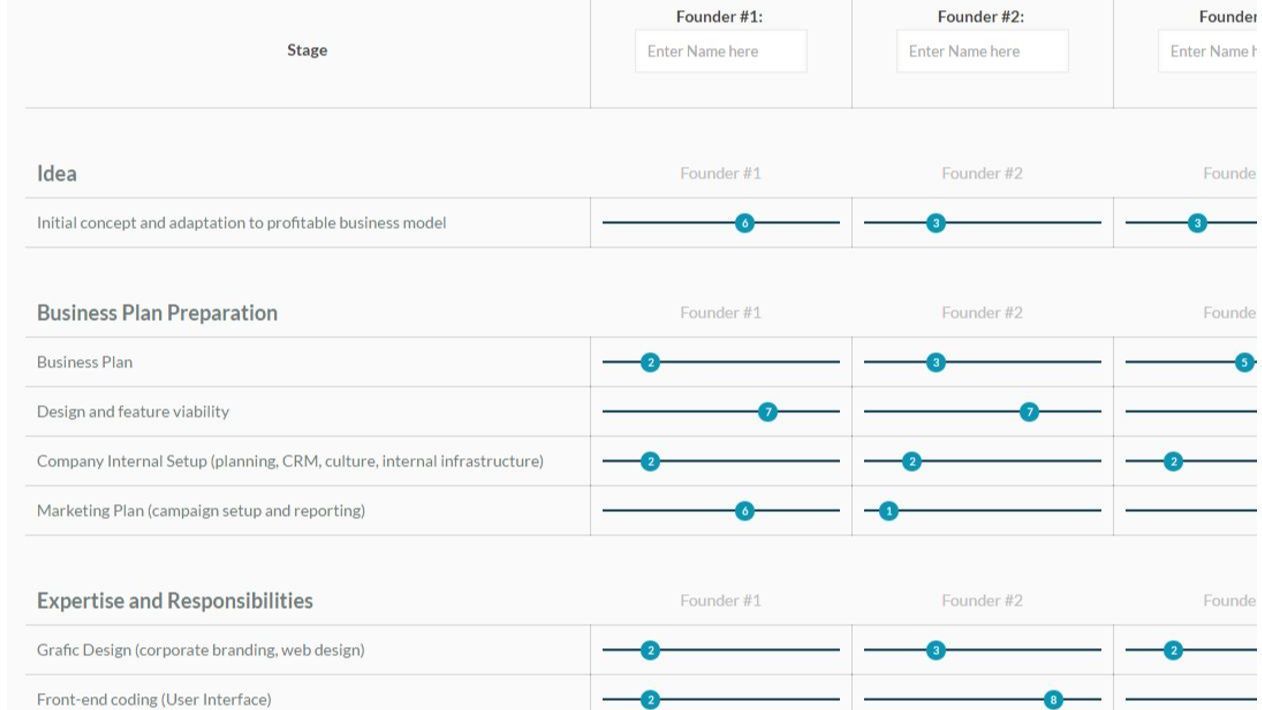Calculating Equity Split Among Founders
eleva8or equity distribution calcula8or is a tool which can help co-founding teams to distribute equity amongst co-founders. It’s human nature that results in co-founding teams distributing equity evenly – even the research shows this is not the best way to distribute equity as founders end up leaving money on the table and also long term contentious issues amongst co-founders may result. Ultimately how to split equity is one of the most important decisions a founding team will make. Noam Wasserman, a Harvard Business School professor spent 15 years studying high-stakes decisions at more than 6,000 startups, says entrepreneurs too often split equity with what he calls a “quick handshake.” Nearly 40 percent of startup teams spend a day or less hammering out an agreement, he says. A large subset of those go the even-steven route. An even split may be the best answer, but if you land there by default rather than after a thorough discussion of expectations and contributions, your team will probably suffer. Wasserman found that unhappiness within teams almost triples when founders split equity equally by default. He estimates that founders who deserve more equity–because they had the original idea, have more relevant experience, or will take a larger role in the company–leave about 25 percent on the table when they agree to an even split, which amounts to an average of about $450,000 in the first round of institutional financing. Here’s how to divide equity without sowing division: Consider Contributions There is no right way to divide equity. But Wasserman’s research shows that founders who had the idea for the company get around 10 to 15 more percentage points of equity than co-founders. Founders who have led other startups generally get 7 to 9 extra points, and the one who becomes CEO gets from 14 to 20 extra points. Ideally, you should allow for unexpected contingencies such as changes in the business model or founders switching roles. If/then planning and vesting schedules are two ways to keep things flexible. “A static split sets you up for disaster,” says Wasserman. An example of Partners in a startup who used eleva8or’s equity distribution calcula8or split their equity roughly 45-30-25 and built in a trigger that would allow two of the founders to buy back stock from the third. Time It Right Companies that split in their first month with little discussion are more likely to split evenly, says Wasserman. Often, these founders are too optimistic, lack information to make another choice, or want to avoid a contentious issue. These companies often take a valuation hit when they go for funding. Investors who believe a simple split does a poor job of appropriately rewarding founders may reduce their investment or insist that the agreement be reworked. A quick, even split “suggests that the founders don’t have the business maturity to have a tough dialogue,” says Wasserman. But founders who wait too long can create internal tension, and individuals may try to maximize their own value at the expense of the company’s interests. Wasserman says the best time to split varies. In fast-changing industries, founders should establish principles they’ll use to draft an equity arrangement, but split only when larger uncertainties are resolved. In more stable industries, splitting in the first few months is a good idea. When you negotiate an equity split with co-founders, be clear, logical, and respectful. If you’re lucky, the equity split will be just the first of many tough decisions you’ll make together. So if your a co-founding team looking for a method to the madness of splitting equity amongst yourselves look no further – use eleva8or’s equity distribution calcula8or. This this will assist the co-founding team with a logical approach to split equity. To try the tool simply create an account on the platform and visit the Resources section to find this tool and several others – and for further questions please contact us at info@eleva8or.com
